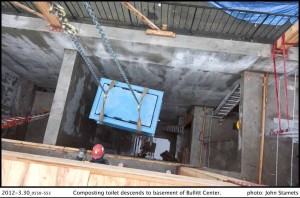Composting Toilets at the Bullitt Center

(C) John Stamets
The Living Building Challenge requires all water to be harvested and treated on site. To meet the Challenge with respect to management of human waste on site, the Bullitt Center team is using Phoenix Composting Toilets from Advanced Composting Systems of Whitefish, Montana.
This system uses a small amount of water and compost is the end result, saving water, saving the energy of treating wastewater, and eliminating nutrient release into the watershed.
To date, the Phoenix Composting Toilet has been installed only in one or two-story structures. Glenn Nelson, who came out from Montana to install the Phoenix composters, was confident about the success of a system involving six floors. The Bullitt Center is taking on many firsts and this is another one.
Here is how the composting toilets work. When a user comes into the stall there is a sensor that can tell if it is a “sitter” or a “stander”. The tank of the toilet contains a soap solution, an air compressor, and water. The soap solution is introduced into the toilet. After use, the waste travels down into one of the 10 composters located in the basement of the building. Each of these units is 84” tall x 40” wide x 61” deep. Inside the composter wood shavings and water combine with the waste, causing it to decompose through the action of aerobic bacteria. A handle on the exterior rotates tines inside the composter. The tines are manually rotated to mix the decomposing waste in order to oxygenate the mixture. Most of the waste is converted into carbon dioxide and water vapor. Leachate gets re-sprayed onto the mixture and there is also a leachate tank to receive any excess. Stabilized leachate is pumped to a vacuum port in the alley where it is picked-up on a monthly basis and taken to a facility where it is combined with other field-ready compost streams. On a regular basis, wood chips will be added to the composters and a small amount of compost will be removed. Sensors and alarms located on each of the composting units will monitor their operation.
Meeting the appropriate sourcing requirements of the Living Building Challenge was made easier by the fact that the composters were fabricated nearby in Montana, well within the distance requirement.
By setting an example of how a six-story office building can operate using composting toilets, the Bullitt Center is establishing a new paradigm for the common office building type.


